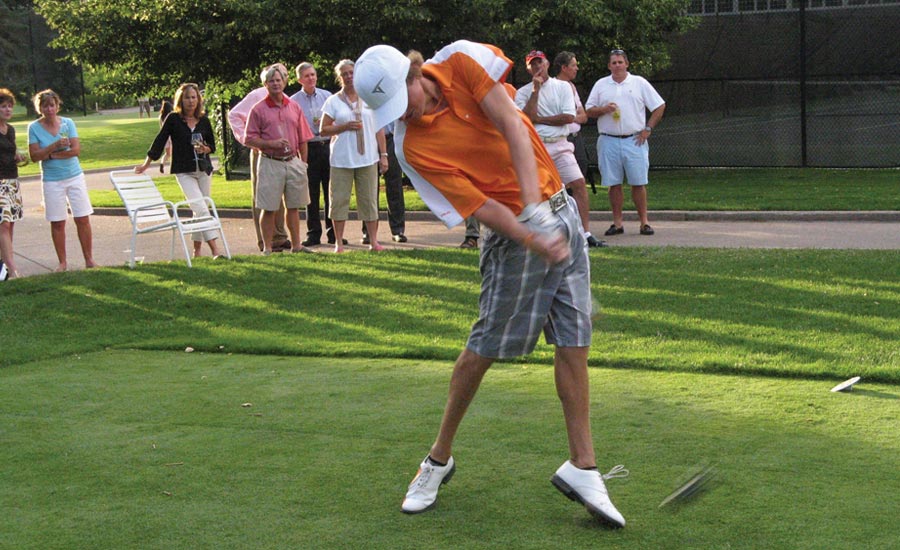
47% of states now say golf is a safe activity, and 79% of golf courses are now open for play. Before you go out and get new shoes, consider that you shouldn’t select your golf clubs just because your favorite pro golfer plays them, and you definitely should not walk in his or her shoes.
Simply put, tour players are leaner than the average person and that has a bearing on shoe selection. The average tour pro on the men’s side is 165 pounds and 70 inches tall, resulting in a body mass index (BMI) of 23.8. The average male is 69 inches tall and 201 pounds with a BMI of 29.7.
That difference is important because swing force summation and BMI result in lateral weight shift loads on the feet and shoes. Tour players have amazingly smooth force transitions, which reduce the lateral support needs of the shoe. These athletes can compete in shoes similar to light cross-trainers because they weigh less per foot size, and their swing transition, while powerful, is exceptionally well-timed.
Their shoes are not well-suited for amateur golfers with much higher weights and BMI numbers. These players have swings marked by more sudden force changes. Combine that with the higher load placed on the shoe in general, and the average recreational golfer requires a more robust shoe that is able to resist sudden, lateral forces as well as extra body weight.
LIGHT ISN’T ALWAYS RIGHT
Golf shoes in the $190–$300 range still have features and construction similar to shoes of 30 years ago. These traditional models perform better in the long run because of increased lateral support.
But as we have seen, golf footwear is trending towards more mesh fabrics. Shoes are much lighter and more breathable but offer nowhere near the lateral transition support of leather.
Another trend, which dovetails with the use of mesh, is that, like some classic athletic shoes, the height of the upper around the heel cup has shrunk over time to lighten the shoe (and, cynics say, to increase manufacturer’s margins).
The minimalist shoe movement has also influenced the decrease in sole thickness, especially at the heel. Many manufacturers claim this gives increased “ground reaction contact,” improving both feel and power. (Again, this might have more to do with profit than performance.) Even with just a little bit of research, minimalist shoes have a less than optimal effect with reducing injuries in runners.
RAMP IT UP
However, a shoe that’s relatively flat from heel to forefoot probably won’t match the “ramp angle” of your work and exercise shoes, most of which have a heel higher than the mid-foot area.
This difference in ramp angles (sometimes termed “heel-forefoot drop”) therefore means all your everyday movements that occur off the course—including those associated with physical conditioning—don’t quite align with those on the course. There have been tour players such as Jason Day who switched shoe brands or styles and immediately had an off year. In running shoes, this is measured from 0-16 mm and influences how the heel strikes during each step.
Think about it: Their swings are so precise that any change in kinesio-mechanics from the ground up changes the rhythm, even if slightly. You can imagine the head games that a different stance and balance point can play.
The best bet is to get golf shoes with similar ramp angles to those in your dress and athletic shoes to better coordinate your movements.
You can assess your dress shoes and athletic shoes with an inclinometer, which measures that ramp angle, and select golf shoes that precisely match.
Another factor that comes into play when considering all the new shoe options is your type of foot. In general, feet that are not as stable do better with straight-lasted shoes, while rigid feet perform well in curved-lasted shoes.
ORTHOTICS
More than half of all tour players use some type of orthotic insole to create a more predictable and reliable weight transfer. Given the extreme weight transfers in golf, which require a stable arch, it is a powerful idea to replace the sock liner of the shoe with an appropriate orthotic.
Unfortunately, not all golf-shoe orthotics work the same way. The golf swing is complicated, and so are the components required to give it appropriate support. Seek out a professional for a custom fitting.
When getting fit, one of the most important things to consider is rigidity. After age 40, feet need a certain amount of “give” under the arch because the fat pads under both the arch and the ball start to lose cushioning, resulting in foot fatigue when you walk the course. So, the orthotic should compensate for the fat pad loss.
Another little-known trick for golf orthotics is the metatarsal bar (or “met bar”), a diagonal ridge that adds a bit of height and rigidity, basically along the line where all the toes start. Applied correctly, the met bar promotes a more efficient weight transfer, resulting in increased power and swing speed.
Golf is the only sport where at least some research has confirmed that adding an orthotic improved power and distance. The participants in the study gained three miles per hour in clubhead speed, which equates to about 10 yards of extra length.
References

